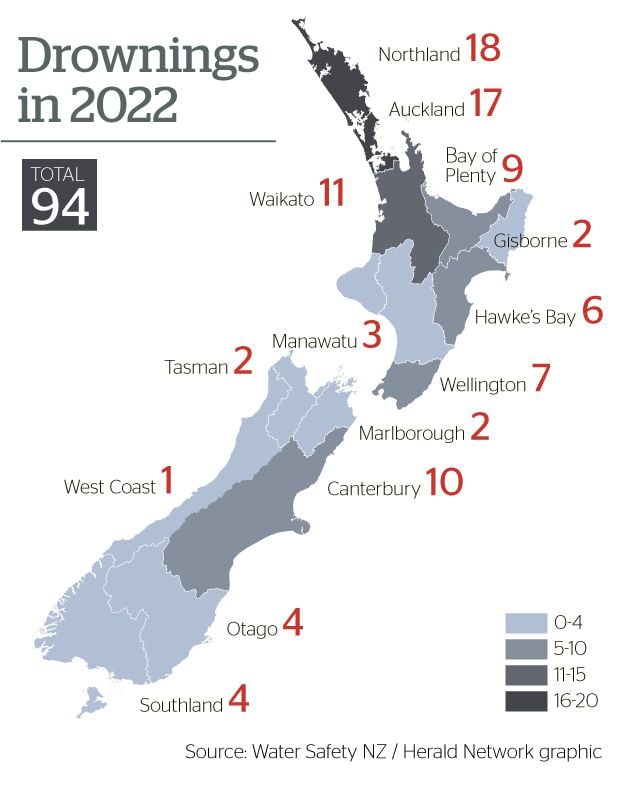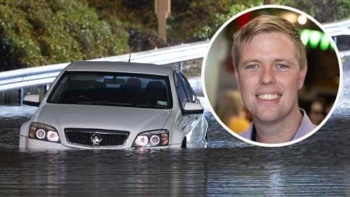A “staggering” number of drownings last year has prompted politicians and water safety advocates to push for mandatory lifejacket legislation to be introduced urgently.
A National MP has a bill in the member’s ballot that would make it illegal to use a vessel 6 metres or less in length unless everyone onboard under age 15 wore a lifejacket, but a Labour Minister doubts the regulation would be effective.
There were 94 preventable drownings in New Zealand last year, the highest in a decade according to Water Safety New Zealand’s latest prevention report.
Nine of those were in the Bay of Plenty, the region with the fifth highest number. Northland topped the list with 18, ahead of Auckland (17), Waikato (11) and Canterbury (10).
The Bay of Plenty figure was one down on 2021 but higher than the 10-year average of 7.7.
Nationwide there were 29 drownings linked to powered craft in 2022 — a 66 per cent increase on the 10-year average of 17.4. Two were in the Bay of Plenty.
It’s a legal requirement to wear lifejackets at “times of heightened risk” in New Zealand, such as crossing bars, in rough water, by non-swimmers, and in an emergency, but bylaws differ from region to region.
In the Bay of Plenty, lifejackets must be worn at all times unless the skipper assessed the risks and advised people it was safe to remove them.
Tauranga MP Sam Uffindell told the Bay of Plenty Times there were “far too many” drownings last year.

He said it was important North Shore MP Simon Watts’ proposed Life Jackets for Children and Young Persons Bill was made law.
In December, Watts wrote to other parties for bipartisan support.
“Unfortunately, Labour didn’t reply which I think is pretty abysmal really because of the dreadful summer that we’ve had,” Uffindell said.
“We need to work together to help bridge these numbers as quickly as we can.”
Watts told the Bay of Plenty Times the bill was signed by every National Party MP but to bypass the ballot it needed 61 MP signatures.
“It’s not the magic bullet for all of the people but the bill has the potential to save lives,” he said.
In response, Associate Transport Minister Kiri Allan said she did not think “National have thought this through thoroughly” because younger people were under-represented in recreational boating fatalities.
Maritime NZ’s recreational batting fatality report 2015-2020 found “a clear over-representation amongst older participants”, with the rate between 50 and 125 per cent higher for those aged over 45. The median age of those who drowned in 2021 was 55.
“Any drowning is one too many but just adding another regulation won’t fix the problem,” Allan said.
/cloudfront-ap-southeast-2.images.arcpublishing.com/nzme/NTLAH4VLYRCD7HBPX3A5LS4TM4.jpg)
Tauranga MP Sam Uffindell. Photo / Alex Cairns
“National needs to explain how this would be practically enforced and what impacts it would have on boaties.
“National’s bill just adds another regulation that doesn’t stack up.”
Allan said the Government trusted “parents to do what’s best for their kids”. Its message was people should wear lifejackets and that it was committed to improving water safety around the country.
Coastguard New Zealand chief executive Callum Gillespie said in a statement this month it “strongly supported” swift action on legislation making lifejackets mandatory.
“There are inconsistencies across Aotearoa and there are too many people dying on the water on days that should be about creating happy memories, safely.
“We have an incredible team of 2000 volunteers and too many of them have had to pull dead bodies from the sea.
“A lifejacket has never ruined a day on the water.”
Last year, four people in the Bay of Plenty drowned at beaches and there were 22 nationwide.
Surf Lifesaving NZ eastern region lifesaving manager Chaz Gibbons-Campbell told the Bay of Plenty Times the 94 drowning deaths figure was “pretty staggering.”
He believed more investment in beach safety signs and education, and public rescue equipment was needed.
“Ultimately lifeguards are really the last line of defence but if we can educate people of the dangers and provide ways for people to help themselves, we’ll hopefully be able to save a lot more lives.”
Gibbons-Campbell said “a lot is at play” when asked why the numbers were so high but said one of the biggest was candid attitudes.
“It’s a ‘won’t happen to me’ kind of mentality.
“Really simply it’s overestimating one’s ability and underestimating the power of the water.”
SLSNZ eastern region lifesaving manager Chaz Gibbons-Campbell. Photo / Alan Gibson
Meanwhile, new research by Auckland University of Technology found surfers save an average of 48 lives each year.
It engaged with 418 surfers that had collectively rescued a total of 1274 people.
Surfing New Zealand chief executive Ben Kennings told the Bay of Plenty Times it was “second nature” for surfers to help people in trouble.
He encouraged swimmers to learn to understand the conditions like whether the tide was going in or out and wind speeds.
Surfing NZ had been rolling out a course, called Surfers Rescue 24/7, to help equip surfers with rescue techniques and CPR skills.
First developed in New South Wales, Australia, Kennings said it provided “a really good asset to the community.”
“It’s really trying to educate the surfing community to say hay this is the best approach to save lives.
“People think it’s of significant value. They’ve learned a lot and people have actually put those techniques into practice this summer.”
Take your Radio, Podcasts and Music with you

/cloudfront-ap-southeast-2.images.arcpublishing.com/nzme/RYCOGLRG5RGH3J5ZMGU4OQ2WAA.JPG)








